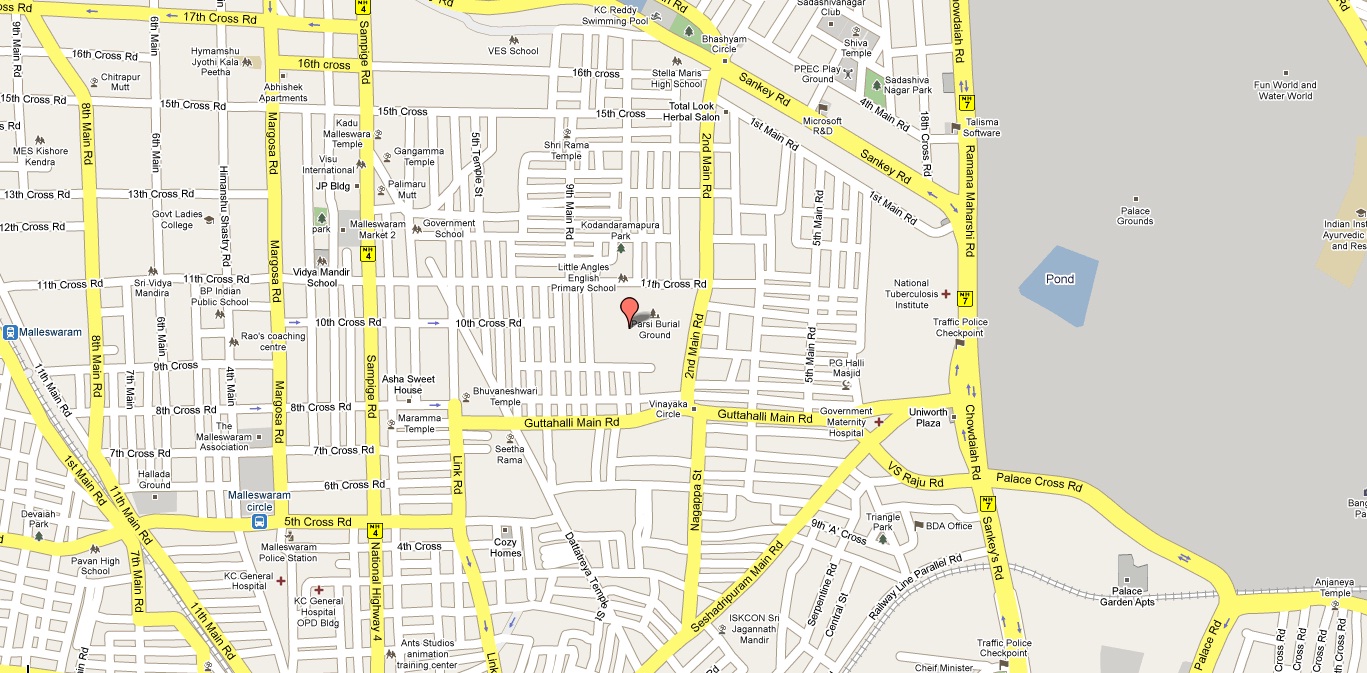
ARAMGAH PROPERTY
LOCATION MAP HISTORY form "The Bangalore Parsis"

The Aramgah
The Parsees of Bangalore felt the need for a burial ground to bury the
body of Mr. Cama. Hence, Dr. Bhabha and
Dr. Choksey met the then Dewan of Mysore, the worthy personality Sir Sheshadri
Iyer and requested him to give a piece of land for Parsee burial. The Dewan knew Mr. Cama so he gave an urgent
order to the Deputy Commissioner of
For the maintenance of this 16½ guntas plot of
land Mrs. Shirinbai Cama (wife of Mancherji Cama) gave Rs. 1,500/- (by way of a
Bombay Port Trust Bond). She also gave
some money to build the compound wall.
The amount was not altogether sufficient to maintain the plot so, in
1896 a book of accounts was started to collect monthly subscriptions from the
families who started coming to
The Parsees were chiefly residing in the
Cantonment area. A gentleman by the name
of Cursetji Anklesaria, with the help of his friends, purchased a one-horse
hearse that he presented to the Parsees.
The approach road too was repaired.
In 1910, Dr. Hormusji Bhabha retired from Mysore Government Service and
left for
At the start of the 20th Century,
(about 1900) the Parsees got together and thought of forming an Anjuman. At first about 15 to 20 families got together
and started contributing money to run their Anjuman. The monthly fee was 8 annas (50 paise), but
some families were not in a position to afford this so they contributed just 4
annas (25 paise). Between 1900 and 1920, the Parsee population rose to
100. As the saying goes ― when more
Parsees get together argument and in-fighting abounds.
In 1920 a great man of the Adenwalla family,
Sir Hormusji Adenwalla, visited Bangalore and purchased a property on
Cunningham Crescent, an old bungalow with a large compound admeasuring 2
acres. The Parsee sethias (sirs) of
those days believed that real wealth lay in possessing lands. It appears that Sir Hormusji Adenwalla was in
possession of 3000 acres of land around
In 1928, one Irani family visited
Between 1910 and 1920, many Parsees came to
settle in
It appears that the Parsee population was about
125 persons by that time. Mr. K. D.
Belgaumwalla thought of establishing an Agiary but he did not survive and the
old Trustees, Mr. B. P. Doctor and Dr. D. K. Darashaw resigned. Now Mr. N. F. Mirza, Mr. H. F. Marker, Mr. F.
F. Dhalla and Mr. Merwanji Manekjee were appointed as the new Trustees.
The Parsees felt the
need for a Prayer Hall, as the Agiary was not in existence then. The Parsees having no place of worship now
set up a small building as a prayer hall in the south portion of the burial
ground with the money given by Mrs. Pirojbai Choksey whose family came to
settle in Bangalore in the 1930s. This was a memorial for her husband Fakirji
and daughter Aimai Balsara. Mr. M.
Manekjee was approached by Mrs. Pirojbai F. China to build a small Prayer Hall
on the plot purchased by the Anjuman, adjacent to the burial ground, measuring
about 25 feet by 15 feet, with verandahs on two sides. This small building was built with the sum of
Rs. 3,500 that was offered by the donors whose photos are hung there in
tribute.